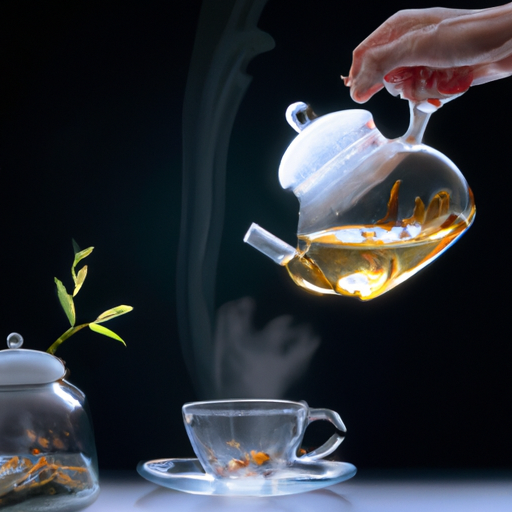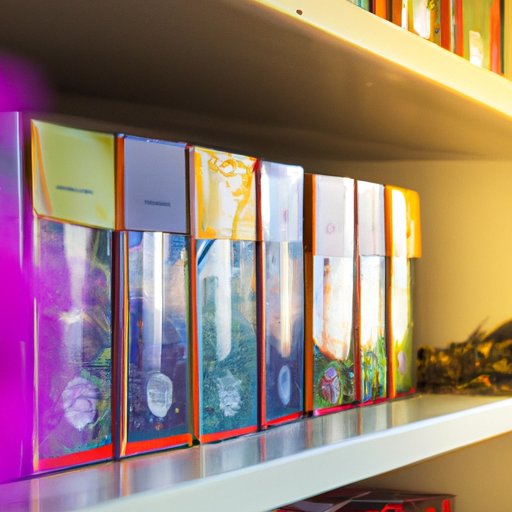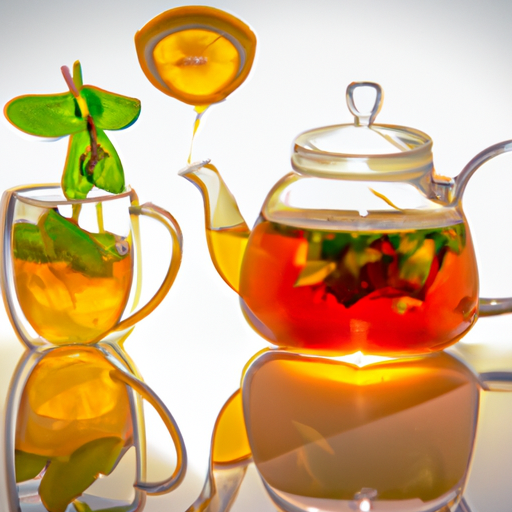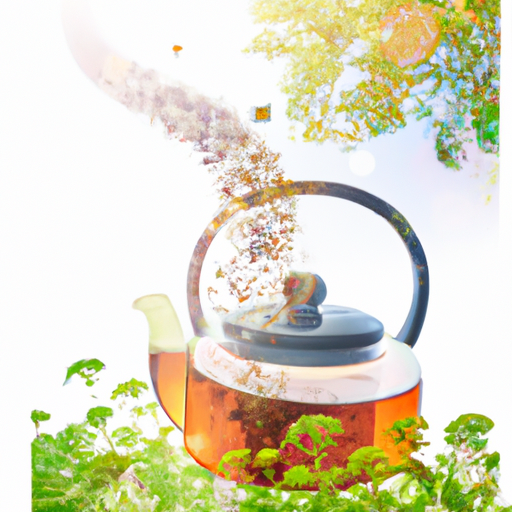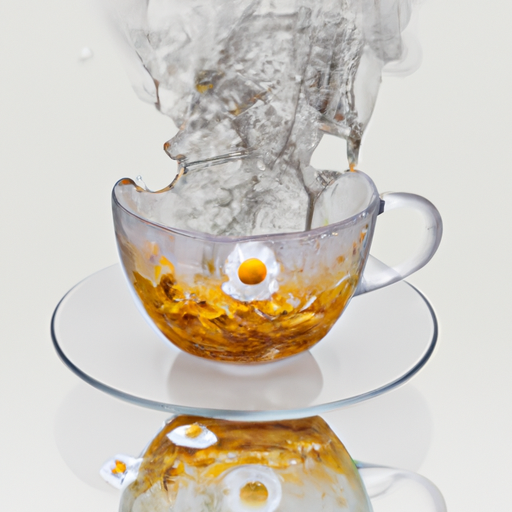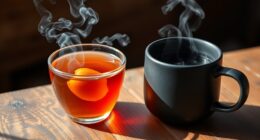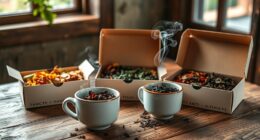Brewing herbal tea is akin to conducting a symphony of flavors and fragrances, with each ingredient contributing its own special note to produce a perfectly balanced elixir.
As I embark on this tea-brewing journey, I am reminded of the delicate dance between art and science, where precision and technique are paramount. With every sip, I savor the warmth and comfort that herbal tea brings, a moment of solace in a busy world.
In this article, I will guide you through the steps to brew herbal tea properly, ensuring that each cup is a masterpiece of flavor and aroma. From selecting the perfect blend to steeping it for just the right amount of time, we will explore the secrets to crafting a cup of herbal tea that is truly exceptional.
So, let us delve into the world of herbal tea brewing and unlock the secrets to creating a perfectly brewed cup, one sip at a time.
Key Takeaways
- Brewing herbal tea requires precision and technique to achieve a delicate balance of flavors and fragrances.
- Different herbal teas have unique flavors and health benefits, such as chamomile tea for calming and peppermint tea for refreshing.
- Herbal tea offers hydration, relaxation, and a reduction in caffeine intake.
- The optimal brewing of herbal tea involves considering factors like the amount of tea used, water temperature, steeping time, and the use of sweeteners and flavorings to customize the taste.
Choose the Right Herbal Tea Blend
Now, you’ll want to choose the right herbal tea blend for your brewing adventure. There are different types of herbal teas available, each offering unique flavors and health benefits.
Chamomile tea is known for its calming properties and is great for relaxation. Peppermint tea is minty and refreshing, perfect for soothing an upset stomach. If you’re looking for a floral taste, try hibiscus tea, which is also packed with antioxidants. For a citrusy kick, go for lemongrass tea, which is known to boost digestion.
Each herbal tea has its own set of benefits, ranging from promoting better sleep to improving digestion and reducing inflammation.
Drinking herbal tea has numerous benefits. It not only helps you to stay hydrated but also provides a natural way to relax and unwind. Herbal teas are free from caffeine, making them a great choice for those looking to reduce their caffeine intake. They’re also packed with antioxidants, which help to fight off free radicals and support overall health.
Now that you’ve chosen the right herbal tea blend, it’s time to measure the correct amount of tea.
Measure the Correct Amount of Tea
First, make sure you’ve got the right amount of tea leaves measured out. The amount of tea you use will depend on personal preference and the strength of flavor you desire. Here are some tips for measuring the correct amount of tea:
- Use one teaspoon of loose tea leaves for every cup of water.
- If using tea bags, one bag is usually enough for a standard-sized cup.
- Adjust the amount of tea based on the size of your teapot or mug.
- Experiment with different amounts to find the perfect balance for your taste buds.
- Remember that some herbal teas may require more or fewer leaves than others.
How to properly steep herbal tea:
-
Boil water to the right temperature.
-
Add the measured tea leaves to a tea infuser or directly to the teapot.
-
Pour the hot water over the tea leaves.
-
Let the tea steep for the recommended time, usually 5-7 minutes.
-
Remove the tea leaves or infuser and enjoy your perfectly brewed herbal tea.
Now, let’s move on to the next step: boiling the water to the right temperature.
Boil the Water to the Right Temperature
To achieve the perfect cup of tea, you need to ensure that you boil the water to the precise temperature that will unlock its full flavor and aroma. Choosing the right teapot and using filtered water are essential steps in this process. The teapot should be made of a material that retains heat well, such as ceramic or glass, to maintain the water temperature throughout the brewing process. Using filtered water eliminates any impurities that could affect the taste of the tea.
Now, let’s talk about the temperature. Different types of herbal tea require different water temperatures for optimal brewing. Here’s a table to guide you:
| Type of Herbal Tea | Water Temperature |
|---|---|
| Chamomile | 200°F (93°C) |
| Peppermint | 212°F (100°C) |
| Green Tea | 175°F (79°C) |
| Hibiscus | 212°F (100°C) |
| Lavender | 195°F (90°C) |
By boiling the water to the right temperature, you ensure that the tea leaves or herbs steep properly, releasing their full flavor and aroma. This creates a more enjoyable tea-drinking experience. Now, let’s move on to the next step: steeping the tea for the right amount of time.
Steep the Tea for the Right Amount of Time
Steeping the tea for the right amount of time is like letting a flower bloom, allowing the flavors to fully develop and create a delightful sensory experience. To enhance the flavor of your herbal tea, here are a few tips to keep in mind.
Firstly, avoid using boiling water for delicate herbal teas as it can overpower the flavors and result in a bitter taste. Instead, opt for water that’s slightly below boiling temperature, around 195°F (90°C).
Secondly, different herbal teas require different steeping times. For example, delicate flowers like chamomile or lavender only need 3-4 minutes, while robust herbs like peppermint or rosemary can be steeped for 5-7 minutes. Oversteeping can lead to a stronger, sometimes unpleasant taste, so it’s essential to keep an eye on the clock.
Lastly, be cautious of common mistakes such as using too much tea or forgetting to cover the cup while steeping. These errors can affect the flavor and aroma of your herbal tea.
By following these guidelines, you’ll be able to brew a perfect cup of herbal tea that’s full of delightful flavors and aromas.
Now, let’s move on to the next step and strain the tea leaves or herbs.
Strain the Tea Leaves or Herbs
Once the flavors have fully developed, it’s time to strain out the tea leaves or herbs, revealing the true essence of your brew.
To achieve this, there are several methods you can use to strain herbal tea effectively. Let’s explore these different methods and the pros and cons of using each type of tea strainer.
-
Tea Infuser: This is a popular choice and a convenient option for many tea enthusiasts. It consists of a small mesh or perforated metal ball that holds the tea leaves while allowing water to flow through. The main advantage of using a tea infuser is that it prevents any loose tea leaves from floating in your cup, providing a clean and smooth tea drinking experience. However, some herbal teas with fine particles may clog the mesh, reducing water flow and potentially affecting the flavor.
-
Tea Strainer: This classic method involves pouring the brewed tea through a fine mesh strainer, removing any larger pieces of leaves or herbs. It is a versatile option that works well with different types of herbal teas. One drawback is that it requires an additional step as you need to pour the tea into a separate container, but it ensures a clear and sediment-free cup of tea.
-
Cheesecloth or Muslin Bag: For larger herbs or tea blends with fine particles, using a cheesecloth or muslin bag can be beneficial. These materials allow the tea to steep freely while trapping any debris. The advantage of using this method is that it provides a clean and clear tea without any residue. However, it may take longer to strain the tea due to the slower flow rate.
Now that you’ve strained your herbal tea to perfection, it’s time to consider adding sweeteners or flavorings, if desired.
Add Sweeteners or Flavorings, if Desired
After straining the tea leaves or herbs, it’s time to add sweeteners or flavorings to enhance the taste of your herbal tea. While herbal teas can be enjoyed plain, adding a touch of sweetness or a burst of flavor can take your tea-drinking experience to the next level.
When it comes to sweeteners, there are several options to choose from. Natural sweeteners like honey, stevia, or maple syrup are great alternatives to refined sugar. Not only do they add sweetness, but they also come with their own health benefits. Honey, for example, has antibacterial properties and can soothe a sore throat, while stevia is a calorie-free option for those watching their sugar intake.
To infuse your herbal tea with unique flavors, get creative with flavorings. Fresh herbs like mint, lavender, or lemon balm can be added to your tea for a refreshing twist. Fruits like citrus slices, berries, or even a splash of fruit juice can add a burst of fruity goodness. Spices like cinnamon, ginger, or cardamom can add warmth and depth to your tea.
By experimenting with different sweeteners and flavorings, you can customize your herbal tea to suit your taste preferences and enjoy a delightful and aromatic cup of tea. So, let’s move on to the next section and discover how to enjoy your perfectly brewed herbal tea.
Enjoy Your Perfectly Brewed Herbal Tea
Now that you’ve enhanced the taste of your herbal tea with sweeteners and flavorings, it’s time to savor every sip and indulge in the pleasure of your perfectly brewed cup. Herbal tea not only offers a delightful taste but also provides numerous health benefits. Let’s explore the different types of herbal tea and their flavors, so you can choose the one that suits your preferences.
-
Chamomile: Known for its calming properties, chamomile tea has a mild and soothing flavor with hints of apple and honey. It’s perfect for winding down after a long day.
-
Peppermint: Refreshing and invigorating, peppermint tea has a cool and minty taste. It aids digestion and can be enjoyed hot or cold, making it a versatile choice.
-
Rooibos: Originating from South Africa, rooibos tea has a naturally sweet and nutty flavor. It’s caffeine-free and packed with antioxidants, making it a great choice for those looking for a healthy alternative.
-
Hibiscus: Vibrant and tangy, hibiscus tea has a slightly tart flavor. It’s rich in vitamin C and known for its potential to lower blood pressure.
By exploring the different types of herbal tea and their flavors, you can find the perfect cup to suit your taste buds and enjoy the numerous health benefits that herbal tea has to offer. So sit back, relax, and relish in the goodness of your perfectly brewed herbal tea.
Frequently Asked Questions
Can I use any type of tea blend for brewing herbal tea?
Sure, you can use any type of tea blend for brewing herbal tea. Just remember that different blends offer various benefits, like relaxation or digestion aid. So, choose wisely to sip on nature’s goodness!
How do I determine the correct amount of tea to use for brewing?
To determine the correct amount of tea for brewing, there are various techniques for tea measurement. These include using a teaspoon per cup or following the instructions on the tea packaging for the recommended quantity.
What is the ideal water temperature for brewing herbal tea?
The ideal water temperature for brewing herbal tea is around 200°F. It’s crucial to use filtered water to enhance the flavor and prevent any unwanted impurities. Remember, the ideal steeping time also plays a vital role in achieving the perfect cup of herbal tea.
How long should I steep herbal tea for optimal flavor?
To achieve optimal flavor, steeping time variations are key when brewing herbal tea. Depending on the type of tea, steeping times can range from 5 to 15 minutes. This allows the flavors to fully develop, resulting in the best herbal tea flavors.
Are there any alternative methods for straining herbal tea aside from using a traditional tea strainer?
When it comes to straining herbal tea, there are alternative methods that can be just as effective as a traditional tea strainer. One popular option is using a tea infuser, which offers the benefits of convenience and easy cleanup.
Conclusion
I hope this guide has helped you learn how to brew herbal tea properly. By choosing the right blend, measuring the correct amount of tea, boiling the water to the right temperature, steeping for the right amount of time, and straining the tea leaves or herbs, you can create a perfectly brewed cup of herbal tea.
And if you want to add some sweetness or flavor, go ahead and do so! So go ahead and brew yourself a cup of goodness, and experience the taste explosion that’ll transport you to a world of pure bliss!

